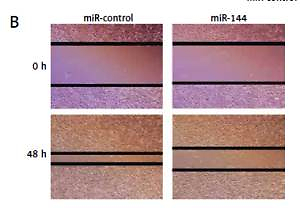Current issue
Archive
Manuscripts accepted
About the Journal
Editorial office
Editorial board
Section Editors
Abstracting and indexing
Subscription
Contact
Ethical standards and procedures
Most read articles
Instructions for authors
Article Processing Charge (APC)
Regulations of paying article processing charge (APC)
ONCOLOGY / BASIC RESEARCH
MicroRNA 144 inhibits cell migration and invasion
and regulates inflammatory cytokine secretion
through targeting toll like receptor 2 in non-small cell
lung cancer
1
Department of Laboratory, The Third People’s Hospital of Dongguan, Dongguan,
Guangdong, China
2
Department of Clinical Medicine, Fujian Medical University, Fuzhou, Fujian, China
3
Department of Education and Science, The Third People’s Hospital of Dongguan,
Dongguan, Guangdong, China
Submission date: 2018-02-24
Final revision date: 2018-05-31
Acceptance date: 2018-06-14
Online publication date: 2020-03-10
Publication date: 2021-07-16
Arch Med Sci 2021;17(4):1028-1037
KEYWORDS
TOPICS
ABSTRACT
Introduction:
MicroRNAs (miRNAs) are endogenous small noncoding RNA molecules involved in modulation of cancer progression. Here, we investigated the possible role of miR-144 in non-small cell lung cancer (NSCLC) development.
Material and methods:
The expression of miR-144 and TLR2 in NSCLC tissue and cell lines was determined by quantitative real-time PCR (qPCR). The TargetScan database was used to predict potential target genes of miR-144. Luciferase assay was used to verify the interaction between TLR2 and miR-144. TLR2 protein expression was measured by western blot. The secretion of interleukin (IL)-1β, IL-6 and IL-8 in A549 cells was detected by an ELISA kit. Cell migration and invasion were evaluated by wound healing assay and transwell assay, respectively.
Results:
Our results showed that miR-144 was downregulated in NSCLC tissue and cell lines when compared with the normal tissues and cell line (p < 0.05). The protein level of TLR2 in NSCLC tissue and cell lines was significantly higher than that in normal lung tissues. Dual luciferase reporter gene assay showed that miR-144 could bind to the 3ʹUTR of TLR2 specifically. Up-regulation of miR-144 significantly decreased the expression of TLR2. Up-regulation of miR-144 or down-regulation of TLR2 could decrease cell migration, invasion and secretion of IL-1β, IL-6 and IL-8 in A549 cells. Moreover, overexpression of TLR2 rescued the inhibitory effects of miR-144 on migration, invasion and inflammatory factor secretion of A549 cells.
Conclusions:
miR-144 could inhibit the migration, invasion and secretion of IL-1β, IL-6 and IL-8 through downregulation of TLR2 expression in A549 cells.
MicroRNAs (miRNAs) are endogenous small noncoding RNA molecules involved in modulation of cancer progression. Here, we investigated the possible role of miR-144 in non-small cell lung cancer (NSCLC) development.
Material and methods:
The expression of miR-144 and TLR2 in NSCLC tissue and cell lines was determined by quantitative real-time PCR (qPCR). The TargetScan database was used to predict potential target genes of miR-144. Luciferase assay was used to verify the interaction between TLR2 and miR-144. TLR2 protein expression was measured by western blot. The secretion of interleukin (IL)-1β, IL-6 and IL-8 in A549 cells was detected by an ELISA kit. Cell migration and invasion were evaluated by wound healing assay and transwell assay, respectively.
Results:
Our results showed that miR-144 was downregulated in NSCLC tissue and cell lines when compared with the normal tissues and cell line (p < 0.05). The protein level of TLR2 in NSCLC tissue and cell lines was significantly higher than that in normal lung tissues. Dual luciferase reporter gene assay showed that miR-144 could bind to the 3ʹUTR of TLR2 specifically. Up-regulation of miR-144 significantly decreased the expression of TLR2. Up-regulation of miR-144 or down-regulation of TLR2 could decrease cell migration, invasion and secretion of IL-1β, IL-6 and IL-8 in A549 cells. Moreover, overexpression of TLR2 rescued the inhibitory effects of miR-144 on migration, invasion and inflammatory factor secretion of A549 cells.
Conclusions:
miR-144 could inhibit the migration, invasion and secretion of IL-1β, IL-6 and IL-8 through downregulation of TLR2 expression in A549 cells.
Share
RELATED ARTICLE
We process personal data collected when visiting the website. The function of obtaining information about users and their behavior is carried out by voluntarily entered information in forms and saving cookies in end devices. Data, including cookies, are used to provide services, improve the user experience and to analyze the traffic in accordance with the Privacy policy. Data are also collected and processed by Google Analytics tool (more).
You can change cookies settings in your browser. Restricted use of cookies in the browser configuration may affect some functionalities of the website.
You can change cookies settings in your browser. Restricted use of cookies in the browser configuration may affect some functionalities of the website.



